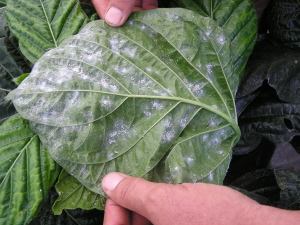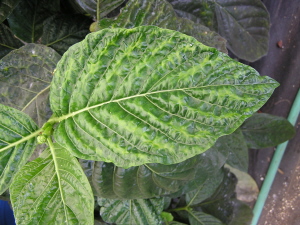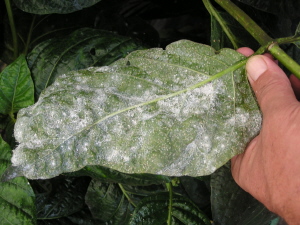Pests and Diseases 
The Spiraling whitefly (Aleurodicus dispersus)


Spiraling whiteflies produce a waxy, hair-like, flocculent material on the undersides of leaves, lending them a white, fuzzy appearnance. |

When noni leaves are heavily infested with the spiraling whitefly , leaves may
be yellow and wrinkled and and have conspicuous deposits of black sooty mold on noni leaf surfaces.
|

A close-up of the underside of a noni leaf heavily infested
with the various life stages of the spiraling whitefly. Note the conspicuous accumulation of white flocculent material on th elower leaf surface. |
The spiraling whitefly is a common sap-feeding insect with a relatively wide host range. Adult females lay eggs in a spiral pattern on leaves. |
|
Pest: The Spiraling whitefly (Aleurodicus dispersus)
Description:
Adults are similar in appearance to many other whiteflies. They are white and quite small (1/12 - 1/8 inch in length and coated with a fine, dust-like waxy secretion. Males and females are winged and resemble tiny moths. Mature pu pae bear copious amounts of a white cottony secretion (sometimes fluffy, sometimes waxy).
Damage: Two types of damage to noni may be caused by the spiraling whitefly: 1) direct damage from feeding; 2) indirect damage from the accumulation of sooty mold and the white flocculent material on leaves (blocking photosynthesis). Sooty mold is a black, non-parasitic fungus that accumulates and grows on the sweet honeydew (a waste product) produced by the whiteflies during their feeding on noni plant sap.
Distribution: The spiraling whitefly is native to Central America and the Caribbean region. It is widespread throughout the Pacific, and is most abundant in coastal areas and elevations below 1000 feet.
Host range: The spiraling whitefly has a relatively wide host range, havign been recorded on 38 genera of plants and more than 100 plant species. The pest attacks many vegetable, ornamental, fruit and shade tree crops in Hawaii. Specific plants that are attacked include cherimoya, atemoya, sugarapple, avocado, 'awa, banana, bird-of-paradise, breadfruit, citru, cocnut, eggplant, guava, kamani, Indian banyan, macadamia, mango, palm, paperbark, papaya, pepper, pikake, plumeria, poinsettia, rose, sea grape, ti and tropical almond.
Control: |
- Foliar applications of insecticidal soaps and oils.
- Manual detachment and removal of heavily infested leaves.
- Canopy management (thinning).
- Weed control (removes potential alternate hosts).
- Avoidance (avoid introducing infested plants into your
nursery or farm).
|
|
Natural enemies: Several natural enemies of this whitelfy have been introduced to Hawaii .
|
|

